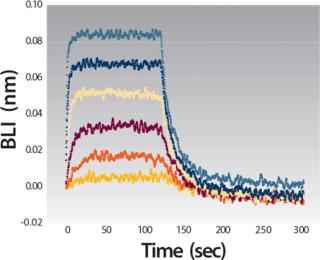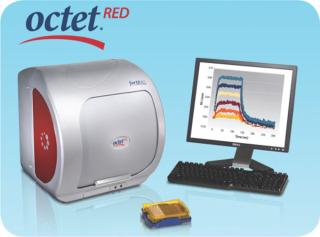Octet RED SystemOctet RED System
July 1, 2008

Figure 1.
Select promising leads earlier in the development process with the Octet RED system’s rapid, highly sensitive detection and label-free analysis of small peptides and small molecules. The Octet RED system’s rapid data acquisition and high sensitivity means that even the fastest reactions and smallest binders will be easily characterized.
The Octet RED system shares the advantages of the Octet QK system: BLI technology, no microfluidics, eight-channel parallel processing, walk-away automation of up to 96 samples, and affordability — while offering expanded detection. By monitoring eight independent interactions simultaneously, the system also increases productivity without additional resources or manpower. The system’s reasonable cost keeps assays in-house with fast, accurate results.
Principle
Protein binding and dissociation events can be monitored by measuring the binding of one protein in solution to a second immobilized on the ForteBio biosensor.

Figure 1. ()

Figure 1. Octet RED System: Rapid Extended Detection for interaction analysis ()
Multiple Analysis Modes
Quantitative kinetic characterization (kobs′, ka′ kd′ KD) without flow-cell fluidics
Binding affinity determination
Concentration analysis for titer determination
High throughput for rank ordering of clones
Kinetic screening of 96 samples in two hours
Epitope mapping
Binding pair selection for protein specific assay development
Biosensor Surface Chemistries
Amine-reactive biosensor: covalent coupling of proteins with a primary amine
Streptavidin: standard or higher binding capacity biosensors that couple to biotinylated proteins
Protein A: recognizes IgG immunoglobulins for titer determination
Anti-Human IgG: recognizes human IgG for titer determination
Anti-Mouse IgG: recognizes mouse IgG immunoglobulins for titer determination
You May Also Like






